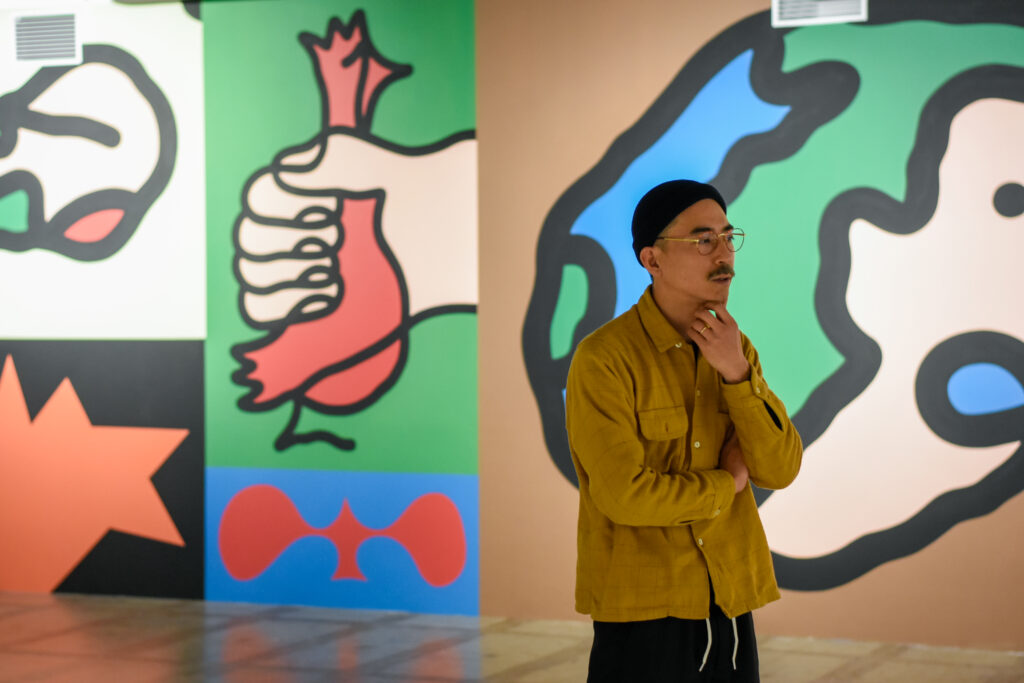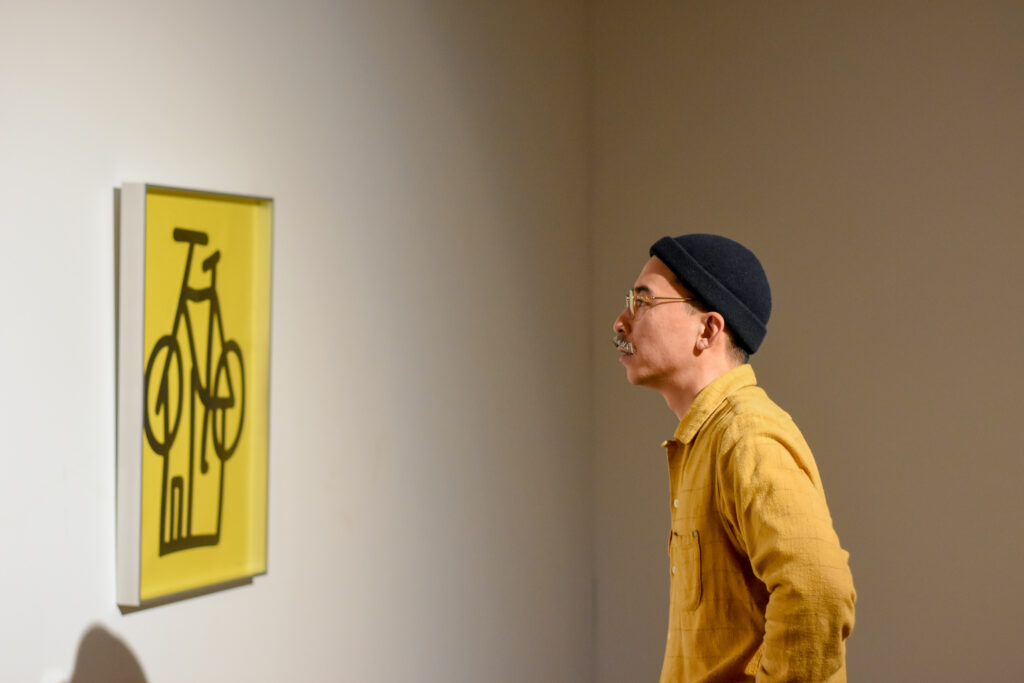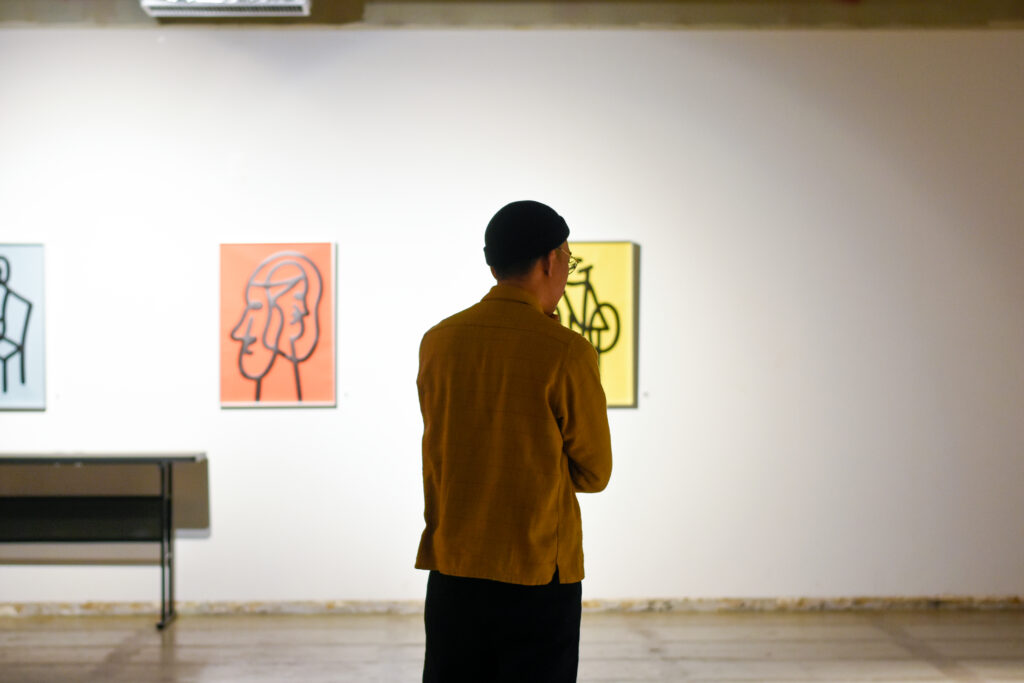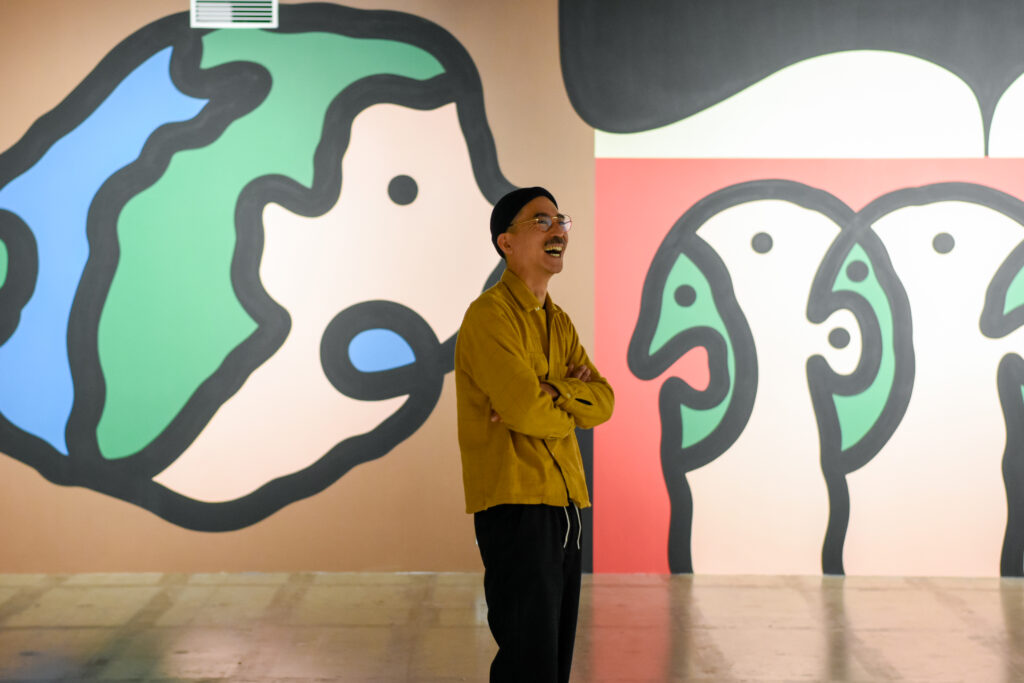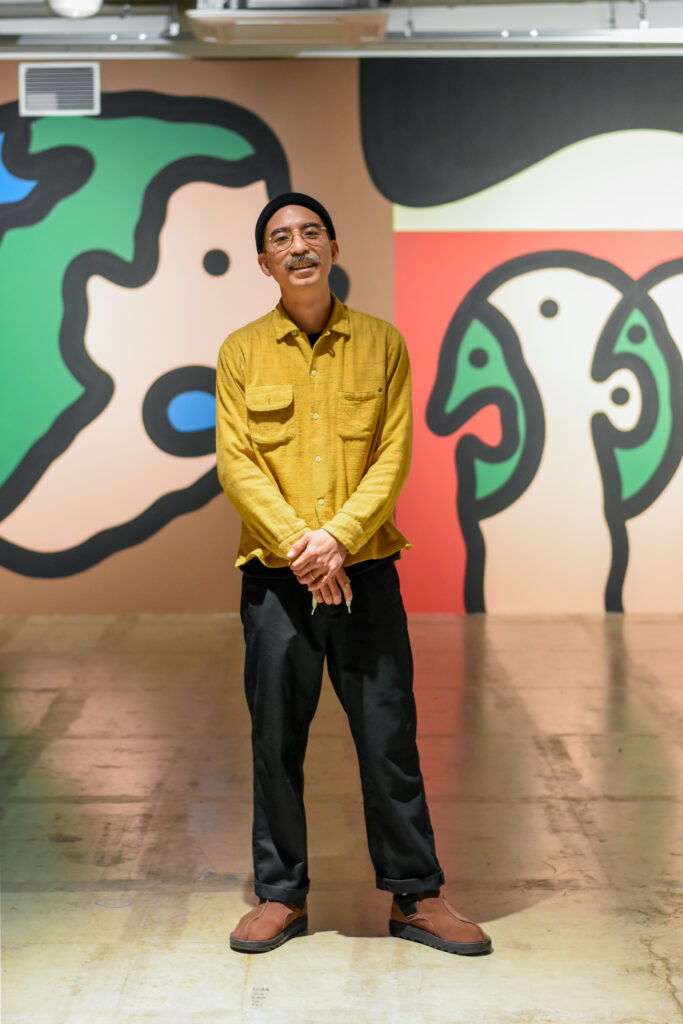


Subterranean Homesick Anti-Hero
Free air flows underground
●Where were you born and raised?
I was born in Nakano, Tokyo. Specifically, I grew up in the area called Nogata and used to hang around the Nakano area since I was in elementary school.
●What did you do for fun during your student days?
When I was in high school, I liked fashion, particularly the brand called “balance wear design”. I used to gather with friends at the Matsuya department store in Nakameguro and wait for the shop to open. I also used to go to Koenji to buy second-hand clothes, and since junior high school, I had been playing drums in a band, so I practiced at a studio, performed live shows, and did regular gigs.
●In Japan, it’s difficult to find space to practice drums, so the number of drummers is relatively small, right?
Yeah, that’s right. It’s difficult to start playing drums because they’re big and noisy. But my family’s home was quite open. I had friends from poor families who went to Nogata Public School. When we went back to my house, they would eat my mother’s homemade dumplings. I would think to myself, “Why did she feed them before me?” But my mother was the kind of person who would feed them because she knew their parents were not at home, so it was a house where my friends were always around. We moved several times within Nakano, but it was like that since elementary school. So in the end, my house was the only place where I could physically have drums. I wanted to play guitar too, but I made a lot of noise in my 6-tatami room. Looking back now, I was really terrible. But my parents never scolded me, come to think of it.
●It sounds like your home and neighborhood were very warm and welcoming! Nakano has a reputation for being deep and interesting, I guess it’s different from other places, so if you have any interesting stories from your childhood, please share them.
I’m the type of person who doesn’t remember much from my past, so I rely on stories from my family and friends to fill in the gaps.
●What kind of person do you think you are?
The first clear memory I have of finding something interesting or liking something was when I was three years old. The older brother of a friend who lived nearby taught me about Shigeru Mizuki, with books like ‘Yokai Dissection Illustrations’ and ‘GeGeGe no Kitaro.’ That’s when I started liking anti-heroes.
●That’s unusual. Usually, when kids are young, they tend to like superheroes like Ultraman or Kamen Rider, right?
I liked yokai and monsters; they’re easier to understand than the heroes. Kids tend to end up liking the same things they see on TV without realizing it. But that older brother taught me about something a bit more obscure. I’m really grateful to him.
●Having someone like an older brother from the neighborhood can be really important, right?
Yes, exactly. That’s why I’m also active in organizing things, with this older brother from the neighborhood mentality.
●It depends on when you go then.
It turns out that the older brother’s mother is also running a snack bar in Nakano, so it might be a family thing. Just knowing that they’re able to do what they love makes me happy.
●Maybe it’s one of the roles in the town. How did you spend your time in college?
I didn’t attend college much, it took me 6 years to graduate. I was in the literature department, so I liked writing, and I used to write documentary-style pieces by listening to people’s stories because I’m interested in people. I’m saying it in a pretentious way, but only when I feel like it. Other than that, I spent most of my time partying, playing in a band, and hanging out. Occasionally, I worked and saved money to travel abroad. Of course, I don’t remember much. But I felt sorry for my parents for the two years I wasted, so I started a standing bar in Hanzomon to make money. Again, I’m saying it in a pretentious way, but I did it because I had nothing else to do. For my graduation thesis, I picked up one person from each customer I met at the bar, ranging from teenagers to people in their 70s, listened to their upbringing and life stories, and created a book called “Human Samples” in the form of interviews, while drinking at their favorite bar.
●Why did you start a standing bar?
It was a narrow property across from my father’s office, like a sleeping place for eels. At first, my father started a bento (boxed lunch) shop to sell cheap and delicious bento to the local people in Hanzomon, where lunch and izakayas (Japanese pub) were expensive. But it was only open during the day, and I thought it was a waste, so I asked if I could run a standing bar at night. I had no intention of running a restaurant, and I couldn’t cook, so I only prepared alcohol and canned food. And for some reason, I set up a corner where people could ride on a rodeo boy, which was popular at the time through mail order, and do shooting for 100 yen per shot. If you hit the most difficult target, you would get a can of crab! I made sure the canned food could be warmed with an alcohol lamp, and I served canned mackerel miso with green onions on top, or oil sardines with cheese on top, just improvised. Surprisingly, or rather fortunately, I became friends with the office workers around Hanzomon who were blessed with customers who came to drink, and I rented out a karaoke pub in the neighborhood and had a party with an age range from 3 to 80 years old. It was the best. Everyone became individuals, taking off their battle gear. The pub mama, an old lady, dressed up in super fashionable clothes and came down the stairs with her friends at the end of the party. She held hands with my friend who was the DJ and danced. It was a GOOD CULT.
●What did you do after graduating from college?
I felt like I had graduated… but then coincidentally, a friend of mine was in San Francisco, a place that I had always wanted to visit. So, I decided to go there and hang out. It was like an extra innings, you know, just going with the flow of things.
●Why did you want to visit San Francisco?
I guess I just liked the atmosphere there or something. It’s not a big city like New York, you know. That’s about it. I also had a lot of artists that I liked who were from there.
●Haight-Ashbury was also a place where the Flower Movement happened. Don’t you feel a similar hippie vibe in the town of Koenji?
Exactly. Not just the size of the town, but I’m also interested in that kind of culture. Because I spent the most time in Koenji, I thought it would be a comfortable place in many ways. Of course, having friends there was a big factor, and I didn’t think too deeply about it. I mean, even if I stayed in Tokyo, I’d be bored.
●How long did you stay in San Francisco?
I stayed for three months until my visa expired. During my time in college, I used to have monthly exhibitions of t-shirts and artwork in Koenji. I was making a lot of t-shirts, and it wasn’t just about my own designs, but also using the works of artists I wanted to collaborate with and displaying their works together with music. I liked planning these kinds of exhibitions and parties. In San Francisco, I brought a lot of screen-printing plates and printed them on clothes I bought at thrift shops. I went to Dolores Park every day and sold or exchanged them with the phrase “Cash or Barter” written on them.
●What kind of people came?
A big mix of people; it was interesting. Some people took off their sweaty t-shirts and came, while others exchanged food they had for candy because they didn’t have money for their children. I thought it was interesting that you can earn money and live a normal life in the park, like earning $100 a day. But after a while, I got a little bored with that kind of feeling.
●What did you do after that?
My friend was working at an art studio in a university, so I gave flowers to the receptionist and became friends with her, pretended to be a student, and took the school bus to sneak in. The studio was well-equipped with tools for creating stuff, so I started making skateboards to kill time.
●You didn’t get found out?
Well, actually, I did. Like, ‘Hey, you’re planning to make a business out of this, right?!’ or ‘Who are you?!’ Before I knew it, I had made about 200 skateboard decks.
●It’s like the power to life, isn’t it?
It wasn’t really a job, but I was happy to receive direct reactions from people.
●When did you go to San Francisco?
It was in 2011. I arrived in San Francisco on the day of the Great East Japan Earthquake, and my friend woke me up saying, “Tokyo is being swallowed by waves!” So I rushed to a nearby deli (similar to a convenience store) and watched it on the TV there, but later I found out that it was false information. So, I don’t really know what the atmosphere was like during the earthquake since I couldn’t watch the news.
By explaining their work to others, they get to know themselves better.
●When did you return to Japan?
I was living as a freeloader with a friend, but the atmosphere turned sour and I was kicked out of the house. I ended up staying with a Chinese couple. They lived in a wealthy area down the hill from an area called Tenderloin, which was an area with lots of junkies. But, influenced by me, the boyfriend stopped working! The atmosphere became slightly awkward. It’s a story where I don’t really recall what happened. And then, as I ran out of money, I survived by collecting spare change from flipping over the sofa and cushions of that house and eating with it. One day, I bought a donut with that spare change and gave it to a homeless person, and at that moment, I realized that I had run out of things to do, so I decided to return to Japan.
●You were living with complete freedom, or rather, pushing the boundaries of freedom to the limit.
It wasn’t intentional, I just did whatever I wanted. As long as I didn’t die, I thought I’d be fine. Nobody knew about me, so I didn’t care what I did. To be extreme, I was even okay with sleeping naked.
●What did you do after returning to Tokyo?
Well, I don’t remember much about the two years after returning home! My father had been using the basement of an office building in Hanzomon as his office, but he said he was going to vacate it, so I decided to rent it. It was a place where I used to party with friends since my teens, and I thought the basement was cool. Let’s have as many exhibitions as possible. So I started a space called “ANAGRA” in that former office in Hanzomon in 2013, and decided that it would end after three years.
●ANAGRA was the location of your father’s office! I went to see a photo exhibition of people from Koenji there recently.
Thank you for going. It’s now called MATTER Gallery. It’s really nice that the younger generation is taking over that place and continuing to have exhibitions and communication without interruption.
●How often did you have exhibitions?
Every week. Creating exhibitions and parties was something I had been doing since my university days, so I made a rule of changing the exhibition once a week and having a party at the beginning and end of each exhibition. It was a crazy pace, sometimes adding exhibitions of overseas artists that came suddenly, and it was really crazy. I was mostly hiding in the basement, so I didn’t get any sunlight at all!
●How did the artists find it?
I used to ask people, “What are you doing?” and found that many of them were doing something interesting. For instance, when I did an exhibit for a graffiti artist friend of mine, he was the son of a Buddhist altar maker, so he wanted to paint a big Buddha all over the wall. So for the opening party, we had these people who were actively acting as monks come in at midnight wearing their robes, and it created a really reverent atmosphere. It was great. At first, I just wanted to paint a picture of the Great Buddha! Not all artists like the party scene and surprisingly, music and art are sometimes separated. Artists may work at home and not interact with the outside world, and even if they exhibit their work, nobody comes without friends. So I wanted the opening and closing of the exhibition to be a place to make friends, an opportunity to trigger communication. We gathered with these types of artists who weren’t good at going out and felt that they didn’t have a place to belong, and we would discuss with them how we could get more unrelated people, or strangers, to look at our works and how artists could make a living. Well, we also got drunk.
●Because writers tend to isolate themselves, but really going outside and talking to people helps you to understand yourself, right?
Yes, that’s right. By explaining their work to others, they get to know themselves better. When they actually meet people and communicate by explaining their work, they become more skilled at using words. But I think I like making things, and maybe it’s because I’ve been watching everyone else making things for so long that I wanted to make things too.
I liked making things and had been watching everyone else make things for a long time, so I ended up wanting to make things myself.
●Everyone tends to ride on invisible rails, so in a way, true freedom can be scary. So, working to remove those rails underground might have been a way to help.
At ANAGRA, office workers from Hanzomon would come to visit, because regular customers from the bar I used to work at in college would come. Then the young people who were spraying graffiti would call me ‘big brother,’ ‘sister,’ ‘uncle,’ or ‘aunt’ and offer me drinks. It was interesting to see their reactions to my art. The Yamato delivery man who always helped me transport my paintings would buy them and give them to his mother as a gift. It made me very happy that people would acquire my artwork as a reaction to their appreciation of it, even though they didn’t have much money to spare for art and would be happy with just a drink. It made me cry tears of joy.
●It’s about each person doing what they can and helping each other out, right?
For three years, we held exhibitions and parties like crazy. I still traveled abroad as usual. I even slept in an elevator. But it was really great that before ANAGRA, I had run a standing bar. Having both experiences was really good. With ANAGRA, of course, there were various challenges, but it was interesting to see how a salaryman in a suit, who seemed like a stealthy office worker, would transform after drinking. There was one regular customer, a man who had a hobby of bondage, who would come in and get tied up with only his underwear on and suspended from the beams in the store. So one time, a normal customer opened the door and saw a salaryman hanging by his underwear! But people still came in. They were forgiven, somehow.
●What was the latter half of ANAGRA like?
It was around the time when I had a child, so I did wonder what I should do in the future, but I didn’t really start thinking about it concretely until after it closed. At first, there were hardly any visitors, but then it started getting featured in magazines and I made a lot of friends with overseas artists. When I went to Tokyo, I found out that if I went to ANAGRA, I could have an exhibition, so the word spread among the scene’s artists. People started coming, and both the artists and myself grew, and our works started selling little by little. But it was still difficult to close ANAGRA after three years, but I think it was a necessary change for my future.
●In the end, where did you end up working?
I went to see Nishino-san, the boss of GAS AS INTERFACE, a company that creates a book called “GAS BOOK” because a friend I often played with at parties worked there for a long time. Of course, I knew about GAS BOOK, and I thought maybe there was something I could do there, so I asked my friend to introduce me to Nishino and I went to talk to him. But he never said “Come work for us” or anything like that. It was like, “Oh, this is not it”. At the same time, I went to see a skater from Yamagata who was also a carpenter named Jiko, and he said, “Come anytime because I’m busy.” I had never done carpentry before, but I liked making things and had been watching everyone else make things for a long time, so I ended up wanting to make things myself. That’s when I found my first mentor and started living a life where I could finally receive a monthly salary, but about a year and a half later, Jiko suddenly went to Germany.
●Germany, huh?
In Germany, all craftsmen have something like a national qualification, and even individual carpenters are recognized as qualified, so the treatment is good, it seems. I couldn’t really tell him not to go, and I liked that kind of thing, so while continuing to work on interior work alone, I was asked by a friend, “Can you make furniture and fixtures?” Even if I couldn’t, I would say I could. So, I started working on various projects, such as opening a shop and making fixtures, gathering several artists, creators, carpenters, and craftsmen to work together. I combined my friends from the time of ANAGRA and the friends I made after starting interior work. Artists often have interesting ideas that professional interior workers or craftsmen wouldn’t think of, so it’s interesting. I’m not a professional in any field, including BOM, and I started getting involved with these artists again in that way.
●What was the trigger for you to return from being a carpenter to running a gallery?
When I quit and the next generation was running ANAGRA, there was a man who came through someone’s introduction and asked me, “Do these artists really make a living doing this? Who is running this place?” When I explained that it was made by this person in this process, it turned out that the person was a wealthy collector who owned works by artists such as Alex Katz and George Condo, and he suddenly called me. When I met and talked with him, he asked if I could run a gallery for him. It was quite unexpected.
●So you decided to run a gallery?
Although I had my doubts, I still liked exhibitions, so I thought I would give it a try and looked for various properties, and I found a good property in Bakuroyokoyama. So I ended up running a gallery there, but ANAGRA was not a gallery, and the original purpose was different…
●Unlike the ANAGRA days, you have more and more things to do…
For example, if a writer sold a piece for 100,000 yen on ANAGRA, but wanted to sell the same piece at a higher price in Harajuku, the cost of rent would increase. It’s become unclear whether they’re selling artwork or working in real estate. There are so many factors that affect the price of artwork. I didn’t like that, so in reaction to that, I decided to start a new place called “HAITSU.” Of course, I think galleries are necessary, and I respect the people involved in them. However, it wasn’t suitable for me. It’s about roles. The most important thing for me is to continue communication centered around exhibitions and artwork.
The main focus is on talking with people based on the exhibition.
●What kind of place is “HAITSU”?
It’s a place where we don’t have to deal with unnecessary expenses or stress, just our own space. I am the only one in charge of the store, and the rent is 30,000 yen. You often hear the term “alternative space” or something like that. But that’s not what I would call it; I wanted to make it a place that is difficult to find. I used to run a gallery called BAF, and when I started BAF, the threshold for seeing and buying artwork had lowered a lot compared to when I started ANAGRA in 2013. So it seemed like a relatively easy thing to do, as long as you had money to buy. But remember when we used to go to live concerts when we were in junior high and high school? They were smelly, dark, and scary. But we still went there to find something. HAITSU is irregularly open, by reservation only, with no public address, and only one group per hour. There’s no signboard, just a room in a run-down apartment. It’s really troublesome, but I want to make sure to entertain and treat the people who come to see the artwork with care.
●So you deliberately created distance from others?
I communicate politely with the people who come and have coffee, beer, or lemon sour as a thank you for coming. They can relax and enjoy the artwork while drinking. The main focus is on talking with people based on the exhibition. About 10 people per day, continuously for one hour each. One-on-one with about 100 people during one exhibition. It’s difficult to have conversations in the atmosphere of a gallery, so it’s hard to talk. I’m worried about whether people understand the artwork and the artists who created them just based on the price list and statement. It’s good if they buy the artwork, but I wonder if they judge solely by appearance. The artists I’ve been working with for a long time have been able to sustain themselves, which is fortunate. But that’s why it’s important to communicate properly. So I named the small apartment in Nishiogikubo ‘HAITSU’ and have been working with artists there to convey our current ideas and values.
●Back to basics, huh?
Exhibitions were supposed to be more interesting, but they’ve turned into businesses for people to consume, and there’s too much emphasis on various things. So, I want to bring the joy back into it. It’s become difficult to follow my own senses, so I want artists to recognize the benefits of exhibitions by creating and showing their works every day, and if their works become better through exhibiting at a proper gallery like HAITSU, I would be happy just to see that.
●Maybe we need to re-think the concept of galleries.
It’s important for the audience to properly view the works and understand the artists, but sometimes both parties get nervous and find it difficult to communicate, and the space becomes uncomfortable.
●By the way, what does the name “HAITSU” mean?
“In English, ‘HEIGHTS’ would mean a high place or something like a Japanese apartment building, I think, but in this case, it’s written in katakana and pronounced in Romanized letters as HAITSU. It’s like the name of an apartment. If you put a strange name, it narrows down the image. It doesn’t really have much meaning.
●So HAITSU means creating space for imagination.
With 30,000 yen, you can have a place. Even high school students can have a space to do what they like if they work part-time. For me, HAITSU is a very important place, to the point that I feel like my mental state would collapse without it. But it’s really run-down, so I think I can only have it for another 2-3 years. Every year, we receive notifications of whether the contract will be extended or not, and it’s bad for my heart…
●How did you end up running the AA gallery?
I was friends with Tane from the ANAGRA days and he introduced me to members of Kabutocho and Media Surf. We talked many times during the planning stages of Keshiki, and I was shown the location after the building was decided, but it turned out that we had to start construction immediately, otherwise, we wouldn’t make it in time. So, we gathered the members who could do carpentry work for the interior, calculated the materials, managed the construction, built walls, and painted the walls and floors. We had to finish it in just a few days. It was good to be able to use my interior construction skills there! Jiko had also returned, so we did the physical labor together. It was fun to gather again after a long time. It’s called a gallery, but it’s a multipurpose space. You can do anything you want.
It's called a gallery, but it's a multi-purpose space. You can do anything here.
●What do you seek in AA?
I think initially we were looking for something more gallery-like, but if we do that, then only people who come to galleries will come. I knew that BAF wasn’t suited for galleries, and I didn’t want to create a specific location because I knew it would add stress. It’s not strictly a gallery, though. Well, it’s called a gallery, but it’s a multi-purpose space. You can do anything here. That’s why I named it with the meaningless sound of “aa.” It’s like the sound of nodding while saying ‘ahh’. Just a sound.
●By chance, it’s another basement, isn’t it?
Yes, exactly. I don’t know how it happened, but the flow from the cafe on the 1st floor down the stairs in the back is similar to ANAGRA. Maybe what I can do is to carefully do what I did at ANAGRA once again here. I’ve also aged a bit, and my way of presenting and communicating has changed, I suppose.
●What kind of exhibitions do you want to host there?
There’s a piece that I’ve been working on with my friend of 10 years, skater and filmmaker Atsushi Sugimoto. It’s been almost 10 years in the making. When I heard that the piece was finally completed at HAITSU, I was struggling to find a place to screen it. Because it’s a video piece, I submitted it to various film competitions, but it was ignored one after another, and I was feeling down. So I thought, ‘This is it’, I want AA to be a place where artists who create intangible works such as videos, music, and physical expressions can freely present their works. Galleries can’t have loud sound or projectors for large-scale videos, and they have to sell tangible works. So I thought it would be nice to give it more of a theater-like function. Sell tickets, even. Fortunately, AA has a reliable sound team called SURD Inc. that can handle that. We could have piano concerts or rakugo performances. Even food exhibitions would be great, I think. I want to make it a more versatile space where such things are possible.
●As a place where you can capture direct reactions, it would be great if more people could experience the sense of freedom you felt in San Francisco, and get to know this underground space, right?
We just want to treat the people who come here with kindness. We do our best to make our works understood and showcase exhibitions that convey that message. We want to create a space like that.
●Can you tell me about your impressions of Kabutocho?
When I first started getting involved here, I already knew about B, SR, and Human Nature, so I felt comfortable from the beginning. There was only ANAGRA in Hanzomon, and I grew up around the Chuo Line, so it was refreshing to hang on the east side of Tokyo. Of course, you can enjoy Kabutocho on its own, but it would be great if this town could become a hub for enjoying Tokyo with a broader perspective, like an expandable location. The roads are wide and flat, there’s a river, and it’s quiet at night. It’s perfect for a stroll.
●You mentioned that you will be moving to Yamanashi. What are your plans for the next step?
Well, I don’t have much planned! I really don’t. Oh, but I want to do something like a dagashiya (a traditional Japanese candy shop). Because I won’t have to worry about rent, I want to do things that I can only do because of that. I don’t need to make money from it. It would be a place for kids. I would display my books, videos, and artworks there. To pass it on to the kids. Not to tell them to do this and think it’s cool, but to show them that there are other options. It would be great if it could inspire people to think differently. I live in a town called Nirasaki, and it would be interesting if the kids in Nirasaki could have an edge. Tokyo has a lot of kids, so it’s hard to stand out, but there are hardly any kids here. Nevertheless, I’ve never really planned my life before, so if something comes up that I feel is necessary, I’ll make it happen. When I look back, I have a wife and kids, a car, and a house. Sometimes when I’m smoking in my backyard, I think it’s a miracle. I was able to do quite a bit in Tokyo, and now I hope to become a big brother to the kids in the local area in the countryside.
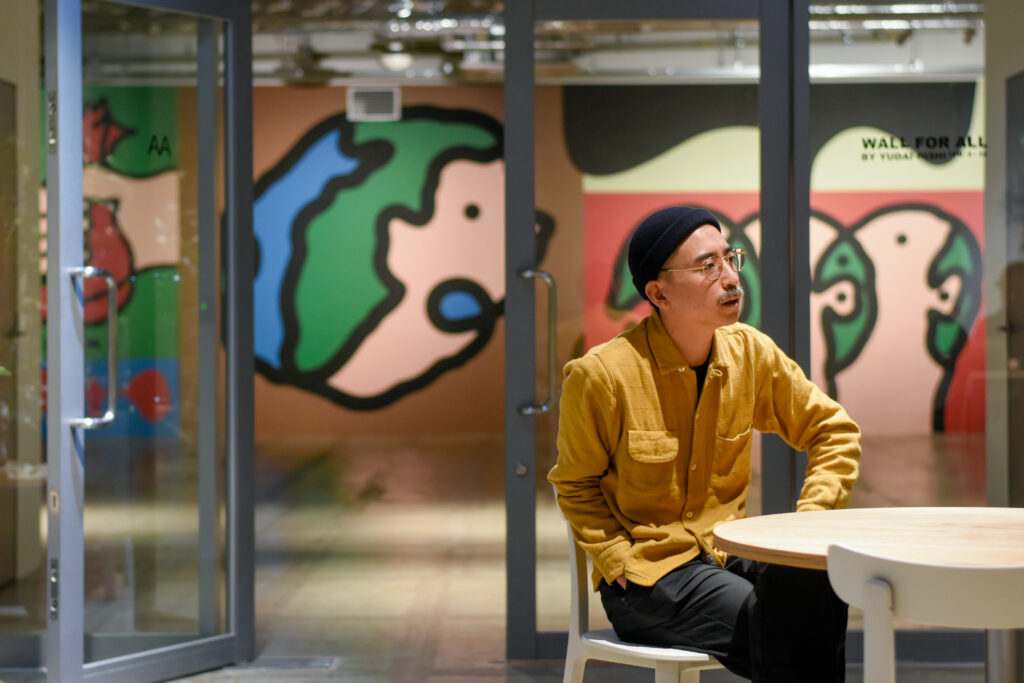
Kotaro Hosono
Born in Tokyo in 1986. Founder of ANAGRA in Hanzomon. After working as a carpenter, he started the invitation-only, non-public viewing room “HAITSU” in Nishiogikubo to regain the sense of enjoyment he once had, due to the discrepancy and discomfort he felt with the gallery and art world. Currently, he continues to introduce various artists from Japan and abroad…
Text : Jun Kuramoto
Photo : Shin Hamada
Interview : Jun Kuramoto
Kotaro Hosono
AA Director
The sight of people who work in suits in Kabutocho
Interesting people in Kabutocho
The sight of people who work in suits in Kabutocho stripped of their professional facade is something I would like to see. Perhaps it is the abundance of food and drink that can strip away that facade, but I would be happy if AA exhibitions could play a part in that. I know that everyone is unique and interesting.
